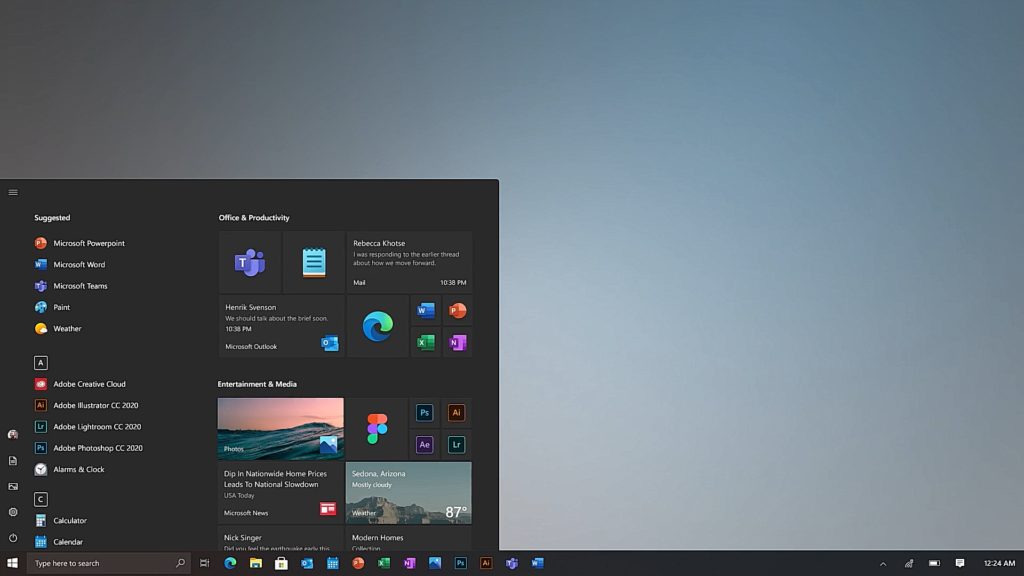


यदि आप विंडोज 10 के लिए नए हैं या अधिक से अधिक कैसे प्राप्त करें, इस बारे में अधिक जानकारी प्राप्त करना चाहते हैं, तो यह वीडियो श्रृंखला आपको इसका उपयोग करने में तेजी लाने में मदद कर सकती है।
इस "होम संस्करण से काम!" श्रृंखला में, लेखक डौग थॉमस त्वरित सहायता के माध्यम से चलता है, यह दिखाता है कि इसे कैसे लॉन्च किया जाए और फिर इसके भीतर, चैट, एनोटेशन जैसी विशेषताओं का उपयोग कैसे करें और स्क्रीन कैसे दिखती है, इसे समायोजित करें।

Windows 10 has officially hit a billion users and Microsoft recently teased upcoming changes to the operating system in a low-quality video. Today, Microsoft has finally posted high-resolution screenshots of Windows 10’s upcoming changes, which gives us a closer look at the new Start menu and other bits and pieces of the refreshed UI.
The new Start menu looks sleeker and simplified, and live tiles are still part of it for select apps such as Weather, News, Mail, and Photos.
As we’ve seen before, the revamped Start menu features new app icons, but older elements haven’t been entirely discontinued yet.
The live and custom colour tiles have disappeared for the most part, but these elements haven’t been entirely discontinued as Microsoft is still using live tiles for apps such as Weather, News and Calendar, where it makes more sense.
The Start menu looks less of a hotchpotch by removing the custom colour for apps that have been around since Windows 8.
If you currently use live tiles for other apps, you can continue to do so according to Microsoft. As you can in the GIF below, the Start menu comes with both Fluent Design icons and rounded corners.
In the previous teaser, Panos Panay showed off the new nicely streamlined File Explorer with a much clearer and less cluttered interface to view your files or folders. For some unknown reasons, Microsoft Edge has replaced File Explorer in the new teaser.
While these improvements are really nice, we still don’t know when this revamped desktop experience will actually arrive. Microsoft hasn’t announced anything on that front, but it’s expected that these interface changes will be part of a Windows 10 preview update later this year, and consumers will see them early next year.
Currently, Windows 10 May 2020 Update is scheduled to arrive later in May and 20H2 minor update is expected to arrive later in 2020.
A new Start menu experience is not a minor change – so we’ll have to until the first update of 2021 for it to arrive in the production branch.

Windows Update doesn’t just automatically update the Windows 10 operating system—it automatically updates hardware drivers, too. That’s resulted in many bugs, but Microsoft is making improvements—and making some of those driver updates optional.
Much has been written about Windows 10’s automatic operating system updates, but hardware drivers often go overlooked. Device manufacturers can upload new versions of their drivers to Windows Update and Windows 10 automatically installs those when they’re available.
Hardware drivers may contain serious security problems or bugs that lead to serious operating system instability. Most people don’t update their hardware drivers manually and most PC manufacturers have terrible driver update utilities. That’s why Windows delivers hardware drivers and their updates through Windows Update.
This also makes it possible to install Windows 10 on a new PC without hunting down most hardware drivers—Windows will automatically find and install the relevant drivers.
Unfortunately, time after time, this automatic update process has led to bugs creeping in. Here are just a few examples. The following drivers were all automatically installed by Windows Update, leading to hardware suddenly breaking for no apparent reason:
Anecdotally, we’ve heard of many other cases of automatic driver updates causing havoc on well-functioning systems. These are just a few of the examples we remember.
It would be nice if these updates received better testing and if some of them were optional. Microsoft is doing just that with some recent changes.

Microsoft now lets driver manufacturers mark some driver updates as “Manual” rather than “Automatic” when uploading them to Windows Update. This new option was made available to manufacturers on Feb. 19, 2020.
Starting with Windows 10’s upcoming 2004 update, also known as 20H1 and expected in Spring 2020, these drivers will be available behind a new “View optional updates” link on the Windows Update Settings screen.
This screen will show you optional driver updates for your PC’s hardware. It reads “If you have a specific problem, one of these drivers might help. Otherwise, automatic updates will keep your drivers up to date.” In other words, Microsoft is encouraging most people not to bother with these updates.
Important driver updates with security fixes and patches for other serious bugs will still be marked “automatic” and will be automatically installed by Windows Update.

Microsoft’s announcement says that all its partners will now be able to mark hardware driver updates as “automatic.” At first, that sounds a little questionable—do we really need more automatic hardware driver updates?
However, it looks like Microsoft is about to do much more testing of these drivers. When a new driver version is marked as “automatic,” it will be slowly rolled out to Windows 10 PCs with “throttling,” just like major updates for Windows 10 are. Only a small number of PC users get the update at first. Microsoft can automatically detect problems and pause the rollout. Windows Update won’t just automatically offer the driver update to all PCs.
Microsoft’s Kevin Tremblay explains how this should make driver updates less buggy in a comment on the Microsoft Tech Community:
All drivers published as automatic are subject to driver flighting, and gradual rollout. During these periods we are reviewing telemetry around the performance of the driver, and it’s effects on overall system health. We catch a lot of driver issues this way before they hit the Windows user base writ large. From an end user perspective we believe this will result in higher quality drivers (stable, performant) being delivered, and a better ability to stay current.
It isn’t clear exactly how many hardware drivers were going through this gradual process prior to February 2020’s change. However, it definitely wasn’t all of them. An article published in 2019 on Microsoft’s Hardware Dev Center portal for hardware manufacturers says “Eventually, all drivers submitted to Windows Update will go through gradual rollout.” That suggests some driver updates were being pushed immediately to all applicable devices without the gradual rollout process.
Microsoft is still struggling with bugs—just look at the recent bug in a security update that’s causing people’s files to vanish.
However, overall, Microsoft has been making Windows 10’s updates more stable. Windows 10’s November 2019 Update was the best yet, and Microsoft is giving the upcoming 2004 update a long bug-testing period at the moment.
Driver updates won’t become bug-free overnight, but requiring driver updates go through the gradual testing process is a sensible step that should improve things.
